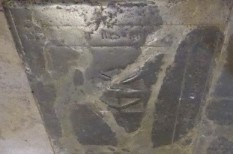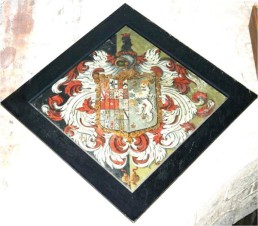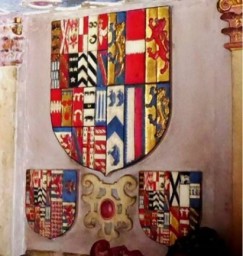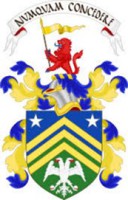
How to Look at Exeter's Colourful Heraldry
Talk by David Oates on Thursday, 13 July 2023
at 7pm at Leonardo Hotel Exeter [Jurys Inn Exeter Hotel]
Our speaker Dr David Oates has been interested in heraldry since his schooldays and helped produce the Devon section of the “Hatchments of England” series. He speaks regularly on heraldic topics, including to the Heraldry Society and the Cambridge University Heraldry and Genealogy Society.
Shields with coats of arms date from the 12th century. This ledger stone in Exeter Cathedral is an early example showing the arms of one of the Magna Carta barons of 1216. In battle, identified by the coat of arms and a distinctive crest on his helmet, the knight became a rallying point for his men and it was clear which side he was on.
“Impalings” of husband (on left) and wife (on right) indicate marriages. Marriage to a (rich) heiress entitled the descendants to add her arms as a “quartering.” Having many quarterings indicated power, inherited property and wealth and boasted of unions with influential or noble families. This hatchment at Poltimore records the death of Sir Coplestone Bampfylde in 1691, displaying many quarterings showing the growth of the family estates. The arms on the right are those of his wife, Jane Pole. The white background shows that she survived her husband.
This hatchment at Killerton, of the “Great” Sir Thomas Acland, 10th Baronet, d. 1871, has Acland quartering Wroth, impaling Hoare – showing the inheritance of lands in Somerset and marriage to the daughter of a banking family. The red-hand badge and the special type of helmet indicate a baronet.
The hatchment, originally in the chapel, was stored in the loft and then hung in the old stables, the visitor entrance to the Killerton estate, but has now been given prominence on the staircase in the main house. Baronetcies were established by James I in 1611 to raise funds for his Irish campaign – costing £1095 each. Cash for honours is nothing new!
David explained that cadency is a man’s position in his family, marked by the use of various devices: 1. Label, 2. Crescent, 3. Mullet (Star), 4. Martlet , 5. Annulet, 6. Fleur de Lys, 7. Rose, 8. Cross Moline, 9. Octofoil.
Matthew Godwin was Master of the Music at Westminster Abbey and then at Exeter Cathedral, dying at the age of 17 in 1586. His monument features a shield with a martlet, showing that he was a 4th son. The wide-brimmed hat with ribbons indicates that he belonged to a clerical order. Cadency marks can be seen on many other shields in Exeter Cathedral and elsewhere.
The impressive arms of Henry Reginald Courtenay, Bishop of Exeter 1797 – 1803, in the Devon and Exeter Institution are an example of “Arms of Office.” The arms of the see of Exeter are in the husband’s position and those of Courtenay in the wife’s – he is literally “married to his job.” He has a mitre instead of a helmet and “supporters” - a fierce heraldic dolphin and boar - which he is entitled to because a bishop was a peer of the realm.
Also, as Prelate to the Order of the Garter he gets the garter as it appears in the royal arms. At the bottom is the Courtenay family motto – “What is true is safe.” Easily missed is the small mullet showing he was a third son.
The recently discovered Royal Arms in Samuels in the Guildhall Centre are those of a Tudor monarch. The Welsh red dragon was prized by Henry VII and his descendants as a symbol of their Welsh origins. The similar arms of Elizabeth I on Mol’s Coffee House have a golden dragon, but it is not clear whether this alteration is just a later paint-over.
Examples of heraldic boastfulness are on the tomb of Sir Hugh Courtenay, 1303-1377, the 2nd Earl of Devon, where the small shields advertise his relationship by marriage to a royal princess. Also, the enormous number of arms and quarterings on the tomb of Sir Gawen Carew 1484-1583 were intended to show he was related to “all the right people” and that this gave dubious entitlement to various estates.
These three coats of arms from the Guildhall are of some of the ancient livery companies of Exeter. The very decorative display above the Lakeland shop comprises recent copies of them.
David pointed out that those who wish to use arms have either to prove their descent from a legitimate holder or obtain a grant of arms from one of the Kings of Arms, costing about £3,000 - having the same surname is not enough. After trying fraudulently to use the arms of the previous owner of his golf course in Scotland, Donald Trump fought an acrimonious 4-year battle with the Lord Lyon King of Arms, resulting in his paying for a grant of a completely new coat of arms. The lion rampant refers to Scotland and the stars to America. Three chevronels denote the sky, sand dunes and sea. The double-headed eagle represents Trump’s dual nationality. The eagle clutches golf balls, celebrating the great game of golf. The motto ‘Numquam Concedere’ is his ‘Never Give Up’ philosophy.”
David finished his most informative talk by showing a humorous version of the arms of the Duke and Duchess of Sussex from ‘The Times.’











